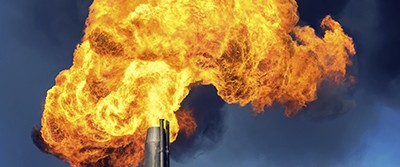Fossil Fuel Use May Emit More Methane Than Previously Estimated

By Christina Phillis
The presence of methane in the atmosphere may be more related to fossil fuel use than previously thought, according to a University of Rochester study published in Nature.
Methane is a very potent greenhouse gas with 80 times the atmosphere-warming potential of carbon dioxide. It is generated naturally or released into the atmosphere by combustion from driving, flying, and other human activities.
The geological sources of methane, whether natural or human activity-related, account for 172 to 195 teragrams of methane per year. The natural portion of those emissions was previously estimated at 40 to 60 teragrams. That figure is now believed to be even lower based on the analysis of methane preserved in ice cores during the past two centuries.
Benjamin Hmiel, atmospheric chemist at the University of Rochester in New York, and his colleagues concluded that modern human activities are responsible for almost all of the current geological emissions of methane.
Measuring Methane
Methane levels were high during the 20th century due to coal mining, natural gas, and other fossil fuel sources. The levels started to taper off at the beginning of the 21st century but began to increase again in 2007 for unknown reasons. Theories include livestock farming, leaky pipelines, and increased microbial activity in wetlands caused by a changing climate. Additionally, less methane is breaking down in the atmosphere.
If current conditions continue, it will be difficult to meet the greenhouse gas reduction goals outlined in the 2015 Paris Agreement, says Euan Nisbet, geochemist, Royal Holloway, University of London, in a Science News article by Carolyn Gramling titled “Fossil fuel use may emit 40 percent more methane than we thought.” Identifying the sources of this methane increase will help us develop reduction targets.
Identifying the Culprits
Before scientists can properly calculate today’s methane emissions, they must establish a baseline for preindustrial methane emissions from natural sources. Separating the biological sources of methane from geological sources is fairly easy. Biological sources have high carbon-14 levels while older geological sources have little or no carbon-14 remaining due to radioactive decay.
Distinguishing human-caused sources of methane from natural sources is a little different. Scientists needed to document levels at a time before human interference, so they turned to methane preserved in ice cores from Greenland that date from 1750 to 2013. During their analyses, they discovered a natural methane figure much lower than previous estimates. They estimate average annual methane emissions before the industrial revolution to be between 1.6 and 5.4 teragrams.
Removing the Uncertainty
Comparing these numbers to current methane emissions indicates that almost all of today’s methane emissions are caused by human-related sources. This adds up to 38 to 58 more teragrams per year, a 35 to 40 percent increase over past estimates. According to Nisbet, this may be positive news because stopping gas leaks and reducing coal mine emissions are relatively easy ways to reduce greenhouse gas emissions.
However, more work needs to be done to find the most accurate measurement of earlier methane levels. Stefan Schwietzke, a Berlin-based environmental scientist with the Environmental Defense Fund, told Science News that ice core data is useful for providing an immediate global snapshot of methane emissions, but is challenging to interpret. Emissions from natural sources are thought to be much higher, but it’s difficult to develop a global number from local measurements. To solve this problem, scientists have started using airborne remote sensing, which can help to identify sources such as leaking pipelines, landfills, dairy farms, and even Arctic permafrost.
Regardless of how methane is measured, reduced fossil fuel use can significantly decrease its levels and related warming effects, a result we can all agree is better.
Discussion Questions
- Research other gases that contribute to global warming. Identify the sources of these gases and find out how scientists measure their levels.
- Why is it so difficult to measure the amount of methane coming from different sources? Brainstorm ways to develop more accurate estimates.
Vocabulary
- Methane
- Geologic
- Emission
- Teragram